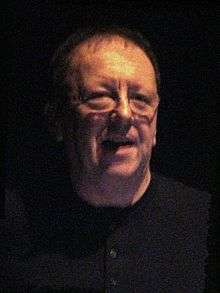Ernest Edmonds

Ernest Edmonds (born 1942, London) is a British artist, a pioneer in the field of computer art and its variants, algorithmic art, generative art, interactive art, from the late 1960s to the present. His work is represented in the Victoria and Albert Museum, as part of the National Archive of Computer-Based Art and Design.
Life and work
Ernest Edmonds is an international expert on Human-Computer Interaction who specialises in creative technologies for creative uses. He was one of the first to predict the value of iterative design and a very early advocate of iterative design methods and Agile software development. He founded the ACM Creativity and Cognition Conference series and was part of the founding team for the ACM Intelligent User Interface conference series.
Edmonds studied Mathematics and Philosophy at Leicester University. He has a PhD in logic from Nottingham University, is a Fellow of the British Computer Society and a Fellow of the Institution of Engineering and Technology. He has nearly 300 refereed publications in the fields of human-computer interaction, creativity and art and was a pioneer in the development of practice-based PhD programmes. Ernest Edmonds is Professor of Computation and Creative Media at the University of Technology, Sydney and Professor of Computational Art at De Montfort University, Leicester, UK.
Art
Edmonds’ art is in the constructivist tradition and he first used computers in his art practice in 1968.[1][2] He first showed an interactive work with Stroud Cornock in 1970.[3][4] He first showed a generative time-based computer work in London in 1985.[5] He has exhibited throughout the world, from Moscow to LA. The Victoria and Albert Museum, London, holds some of his artwork and is collecting his archives within the National Archive of Computer Based Art and Design.
In 2014 Edmonds curated a seminal historical exhibition, Automatic Art, at GV art gallery, London.;[6][7] The show included works by Harold Cohen, Anthony Hill, Malcolm Hughes, Michael Kidner, William Latham, Kenneth Martin, Mary Martin, Jeffrey Steele and Susan Tebby.
Selected exhibitions
- 2013
Ernest Edmonds, Conny Dietzschold Gallery, Sydney
Transformations: Digital Prints from the V&A collection, Royal Brompton Hospital, UK
- 2012/3
Light Logic. Site Gallery, Sheffield, UK
Selected New Acquisitions. Victoria and Albert Museum, London
- 2012
Intuition and Integrity, Kinetica, London; Lighthouse, Brighton; Lovebytes, Sheffield, Phoenix, Leicester
Transformations: Digital Prints from the V&A collection, Great Western Hospital, Swindon, UK
Visualise Poetry, Language, Code, Cambridge, UK
- 2010
Grid Gallery, Vivid festival, Sydney
- 2009
When Ideas Become Form—20 Years, Conny Dietzschold Gallery, Sydney
Cities Tango, Conny Dietzschold Gallery, Sydney and ISEA, Belfast
- 2007
Ernest Edmonds and Alf Loehr, Conny Dietzschold Gallery, Sydney
Speculative Data and the Creative Imaginary, National Academy of Sciences Gallery, Washington DC
ColorField Remix, WPA\C Experimental Media Series (performance), Corcoran Gallery of Art, Washington DC
- 2005
White Noise, Australian Centre for the Moving Image, Melbourne
Ernest Edmonds and David Thomas, Conny Dietzschold Gallery, Sydney
Minimal Approach… Concrete Tendencies, Tin Sheds Gallery, University of Sydney
- 2004
Australian Concrete Constructive Art, Conny Dietzschold Gallery, Sydney
SIGGRAPH Art Exhibition, Los Angeles
GRAPHITE Art Exhibition, Singapore
Sonar2004Festival, Barcelona
- 2000
Global Echos. Mondriaanhuis, Amersfoort
Constructs & Reconstructions, Loughborough University
2000: Relativities, Bankside Gallery, London, and tour
- 1999
Galerie Jean-Mark Laik, Koblenz Science in the Arts—Arts in Science, Hungarian Academy of Fine Arts, Budapest
- 1994
Digital Arts, The Mall Gallery, London
Friends of Mesures. Vervier and Antwerp
- 1990
SISEA, Groningen—collaborative performance
Avant Garde 1990, Manege, Moscow
Art Creating Society. Museum of Modern Art, Oxford
Heads and Legs. Liege (one-person) including a collaborative performance
- 1989
Constructivism versus Computer. Galerie FARO, World Trade Centre, Rotterdam
Re-Views: Contemporary systematic and constructive arts. The Small Mansion Arts Centre, London
- 1988
Null-Dimension. Galerie New Space, Fulda (and 1989, Gmunden, Austria)
- 1985
Duality and Co-existence. Exhibiting Space, London (one-person).
- 1975
2nd International Drawing Biennale. Middlesbrough Art Gallery, Cleveland, and tour
- 1972
Cognition and Control. Midland Group Gallery, Nottingham
References
- ↑ Franco, Francesca (2013). "Exploring Creative Intersections: Ernest Edmonds and his time-based generative art". Digital Creativity. 24 (3): 225. doi:10.1080/14626268.2013.835699.
- ↑ Edmonds, Ernest (2002). "Structure in Art Practice: Technology as an Agent for Concept Development". Leonardo. 35 (1): 65–71. doi:10.1162/002409402753689344.
- ↑ Cornock, Stroud; Edmonds, Ernest (1973). "The Creative Process Where the Artist Is Amplified or Superseded by the Computer". Leonardo. 6 (1): 11–16. doi:10.2307/1572419.
- ↑ Edmonds, Ernest; Franco, Francesca (2013). "From Communication Game to Cities Tango". International Journal of Creative Computing. 1 (1): 120–121. doi:10.1504/IJCRC.2013.056938. Retrieved 16 December 2014.
- ↑ Franco, Francesca (2013). "Exploring Creative Intersections: Ernest Edmonds and his time-based generative art". Digital Creativity. 24 (3): 231. doi:10.1080/14626268.2013.835699.
- ↑ Automatic Art : Human & Machine Processes Make Art. Trebuchet Magazine (2016-05-13). Retrieved on 2016-05-17.
- ↑ Ings, Simon. (2014-08-02) When art changes the rules for science. New Scientist. Retrieved on 2016-05-17.
Bibliography
- Franco, Francesca (2013). "Documenting Art as Art: the case of Notes (2000-ongoing) by British artist Ernest Edmonds". Visual Resources – an International Journal of Documentation. 29 (4): 2013. doi:10.1080/01973762.2013.846793.
- Ernest Edmonds and Francesca Franco, "Art of Conversation," Ideas before their time – Connecting the past and present in computer art, Franco, F., Gardiner, J., Lambert, N. (Eds.), British Computer Society, London 2010.
- Francesca Franco, "Ernest Edmonds' Experiments in Colour, Structure, Time and Space," Ernest Edmonds: Light Logic, Laura Sillars (Ed.), Sheffield: Site Gallery, 2012.
External links
- Ernest Edmonds website
- List of Edmonds' works held by the Victoria and Albert Museum
- Ernest Edmonds' page at Digital Art Museum
- http://dada.compart-bremen.de/item/agent/580
- http://www.artnet.com/galleries/conny-dietzschold-gallery/artist-ernest-edmonds/
- http://www.sitegallery.org/archives/4849
- http://www.leoalmanac.org/editorial-board/ernest-edmonds/
- http://www.dmu.ac.uk/about-dmu/academic-staff/art-design-humanities/ernest-edmonds/ernest-edmonds.aspx